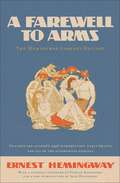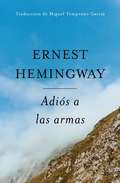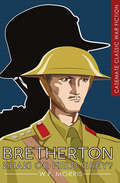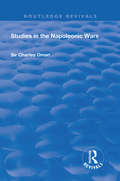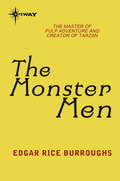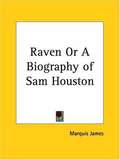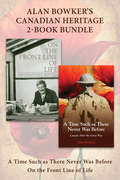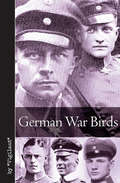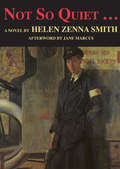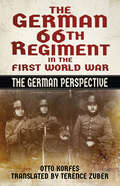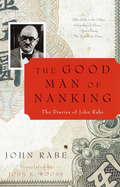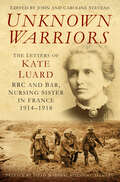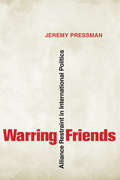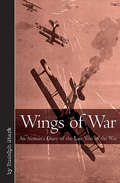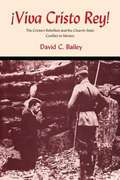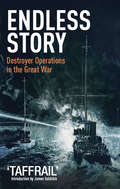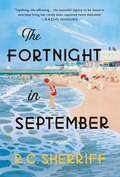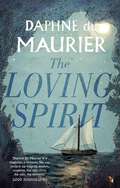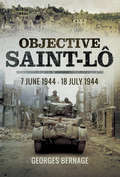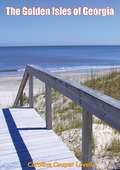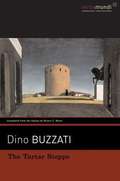- Table View
- List View
A Farewell to Arms: The Hemingway Library Edition (Hemingway Library Edition)
by Ernest HemingwayThe definitive edition of the classic novel of love during wartime, featuring all of the alternate endings: &“Fascinating…serves as an artifact of a bygone craft, with handwritten notes and long passages crossed out, giving readers a sense of an author&’s process&” (The New York Times).Written when Ernest Hemingway was thirty years old and lauded as the best American novel to emerge from World War I, A Farewell to Arms is the unforgettable story of an American ambulance driver on the Italian front and his passion for a beautiful English nurse. Set against the looming horrors of the battlefield—weary, demoralized men marching in the rain during the German attack on Caporetto; the profound struggle between loyalty and desertion—this gripping, semiautobiographical work captures the harsh realities of war and the pain of lovers caught in its inexorable sweep. Ernest Hemingway famously said that he rewrote the ending to A Farewell to Arms thirty-nine times to get the words right. This edition collects all of the alternative endings together for the first time, along with early drafts of other essential passages, offering new insight into Hemingway’s craft and creative process and the evolution of one of the greatest novels of the twentieth century. Featuring Hemingway’s own 1948 introduction to an illustrated reissue of the novel, a personal foreword by the author’s son Patrick Hemingway, and a new introduction by the author’s grandson Seán Hemingway, this edition of A Farewell to Arms is truly a celebration.
Adios a Las Armas (Spanish Edition)
by Ernest HemingwayUna inolvidable historia de amor entre una enfermera y un joven soldado idealista en la Italia de la I Guerra Mundial. Por el Premio Nobel de Literatura Ernest Hemingway.No amaba a Catherine Barkley, ni se le ocurría que pudiera amarla. Aquello era como el bridge, un juego donde te largas a hablar en vez de manejar las cartas. Eso pensaba el teniente americano Frederic Henry, conductor de ambulancias en el frente italiano durante la Primera Guerra Mundial, al poco de conocer a esta bella enfermera británica. Lo que parecía un juego se convirtió en pasión intensa, mientras la guerra lo arrasaba todo y los hombres desfilaban bajo la lluvia, agotados y hambrientos, sin pensar más que en huir de la muerte. Inspirada en las vivencias de Hemingway, Adiós a las armas es ya un clásico de la literatura universal y uno de los mejores retratos de la voluntad humana.
Bretherton: Khaki or Field Grey? (Casemate Classic War Fiction #1)
by W. F. MorrisThis World War I novel is &“a mystery as exciting as a good detective story and an extraordinarily vivid account of trench-warfare&” (The Sunday Times). In November 1918, as the Germans are in their final retreat, a British raiding party under fire follows the sound of piano music and stumbles across an eerie scene in a ruined chateau. A German officer lies dead at the keys, next to a beautiful woman, also deceased, in full evening dress. But what makes their discovery especially strange is that the man is the spitting image of G. B. Bretherton, a British officer missing in action. This tale of mystery and identity, first published in 1930, is not only an authentic account of the brutal conditions at the battlefront, it&’s also a remarkable thriller with a twisting, unusual plot that earned it comparisons to John Buchan and the best espionage writers. The Morning Post called it &“one of the best of the English war novels&”—while Sir John Squire, the influential editor of the London Mercury, went a step further and labeled it &“undoubtedly the best.&” Eric Ambler, the iconic author of such classics as A Coffin for Dimitrios and Journey into Fear, considered it one of the five best spy novels of all time. Fans of war stories and suspense novels alike—and readers of modern WWI tales like Robert Olen Butler&’s The Star of Istanbul—will find themselves caught up in this lost gem from the Great War era.
Revival: Studies in the Napoleonic Wars (Routledge Revivals)
by Charles OmanThis book presents a general summary of the views on the history of the world held by various historians’ perspective. Rest of the book is derived from author’s main work of 20 years on the Napoleonic period. Narrative includes four stories of the Secret Service that illustrate in different fashions the underworld of political and military intrigue which escapes notice in other general history work. Some of the material included in this book is derived from the study of the British tactics before the Peninsular War and helps to comprehend Duke of Wellington’s methods of warfare with Napoleon and his armies. Discussion is included on Napoleon’s system of using his cavalry as a generalization with a specific study of the handling of the cavalry by his generals in the Spanish War.
Single-Handed
by C. S. ForesterThis is the story of a man alone on a remote Pacific island with a rifle and a deadly decision - a decision which brings to a powerful climax the threads of three lives.
The Monster Men
by Edgar Rice BurroughsThey called him Number Thirteen, the latest and best of Dr. Von Horn's attempts to make life from lifeless chemicals. He found himself an almost-human on Von Horn's hideaway jungle island off the coast of Borneo. He saw the monsters that had preceded him and grew used to those dreadful travesties of humanity. Not until Number Thirteen met the American girl who was Von Horn's unwilling prisoner did he realize how different he was from the others. Because, monster or not, he turned against his master and threw in his lot with the girl and his friends in their desperate effort to escape the island of terror. The story of THE MONSTER MEN is an Edgar Rice Burroughs novel of savages, primitive monsters and jungles in the best Tarzan style.
The Raven: A Biography of Sam Houston
by Marquis JamesThis work tells the tale of Sam Houston: United States Senator; military hero; protégé of Andrew Jackson and Tennessee's Young Man of Destiny; General and President of the Texas Republic; Ambassador of the Cherokee Nation of Indians and adoptee of the Cherokee people; and as trouble brewed with Mexico, he was chosen commander in chief of the Texan provisional government.<P><P> Pulitzer Prize Winner
Alan Bowker's Canadian Heritage 2-Book Bundle: A Time Such as There Never Was Before / On the Front Line of Life
by Alan BowkerIn this two-book bundle, Alan Bowker sheds new light on two subjects with a surprising connection: the great Canadian writer Stephen Leacock and the rise of Canada on the world stage, which Leacock profiled with keen wit and observational skill. With Bowker as your guide, explore what it was really like to live through the great upheaval that pushed Canada to come into its own on the world stage. A Time Such as There Never Was Before Ottawa Book Award 2015 — Shortlisted The years after World War I were among the most tumultuous in Canadian history: a period of unremitting change, drama, and conflict. They were, in the words of Stephen Leacock, “a time such as there never was before.” The war had been a great crusade, and its end was supposed to bring a world made new. But the conflict had cost sixty thousand Canadian lives, with many more wounded, and had stirred up divisions in the young, diverse country. With Canada struggling to define itself, labour, farmers, business, the church, social reformers, and minorities all held extravagant hopes, irrational fears, and contradictory demands. Whose hopes would be realized, and whose dreams would end in disillusionment? Which changes would prove permanent and which would be transitory? A Time Such As There Never Was Before describes how this exciting period laid the foundation of the Canada we know today. On the Front Line of Life In the last decade of his life, Stephen Leacock turned to writing informal essays that blended humour with a conversational style and ripened wisdom to address issues he cared about most — education, literature, economics, Canada and its place in the world — and to confront the joys and sorrows of his own life. With an introduction that sets them in the context of his life, thoughts and times, these essays reveal a passionate, intelligent, personal Leacock, against a backdrop of Depression and war, finding hope and conveying the timeless message that only the human spirit can bring social justice, peace, and progress.
German War Birds (Vintage Aviation Library)
by Claude W. SykesDramatic true stories of air combat featuring Germany&’s greatest pilots: &“AWorld War I aviation history classic&” (Over the Front). In these riveting accounts, Manfred von Richthofen, Max Immelmann, Oswald Boelcke, and other famous daredevil flyers are joined by lesser-known but equally resourceful colleagues such as Rudolf von Eschwege and Hans Schüz as they take part in furious battles in the sky—and close escapes on the ground when brought down on the wrong side of the lines. German War Birds contains some of the earliest information to appear after the war about air combat in the Middle East and Russia, as well as the Western Front, and about the significance of observation balloons as targets that were viciously attacked. The author focuses on the heart of the action and recreates the experiences of the airborne war with immediacy and excitement—drawing the reader into events as they happen.
Not So Quiet...: A Novel (Women And Peace Ser.)
by Jane Marcus Helen Zenna SmithThis story offers a rare, funny, bitter, feminist look at war from women actively engaged in it. Published in London in 1930, Not So Quiet...(on the Western Front) is a novel in autobiographical guise that describes a group of British women ambulance drivers on the French front lines during World War 1. As Voluntary Aid Detachment workers, the women pay for the privilege of driving the wounded through shell fire in the freezing cold, on no sleep and an inedible diet, under the watchful eye of their punishing commandant, nicknamed Mrs. Bitch.
The German 66th Regiment in the First World War: The German Perspective
by Terence Zuber Otto KorfesGerman Infantry Regiment 66 fought in most of the great battles on the Western Front in the First World War: Le Cateau, First Marne, Arras 1915, the Somme, Chemin des Dames 1917, the German March 1918 offensive, Chemin des Dames 1918, Second Marne and the Siegfried Line. This is the official regimental history, written in 1930 by Major Dr Otto Korfes, an officer in the regiment for most of the war and a Reichsarchiv historian.The German 66th Regiment in the First World War presents a unique insight into the German Army during the Great War, showcasing a perspective all too often ignored. Translated by German Army expert Terence Zuber, it includes maps and pencil sketches by the famed German war artist Döbrich-Steglitz. Containing a viewpoint that will add balance to anyone’s knowledge of the events of 1914–1918, this volume is a must-read for military historians and enthusiasts alike.
The Good Man of Nanking
by John RabeThe Good Man of Nanking is a crucial document for understanding one of World War II's most horrific incidents of genocide, one which the Japanese have steadfastly refused to acknowledge. It is also the moving and awe-inspiring record of one man's conscience, courage, and generosity in the face of appalling human brutality.Until the recent emergence of John Rabe's diaries, few people knew abouth the unassuming hero who has been called the Oskar Schindler of China. In Novemgber 1937, as Japanese troops overran the Chinese capital of Nanking and began a campaign of torture, rape, and murder against its citizens, one man-a German who had lived in China for thirty years and who was a loyal follower of Adolph Hitler-put himself at risk and in order to save the lives of 200,000 poor Chinese, 600 of whom he sheltered in his own home.From the Trade Paperback edition.
Unknown Warriors: The Letters of Kate Luard, RRC and Bar, Nursing Sister in France 1914-1918
by John Stevens Caroline Stevens AllenbyThe words of Unknown Warriors resonate as powerfully today as when first written. The book offers a very personal glimpse into the hidden world of the military field hospital where patients struggled with pain and trauma, and nurses fought to save lives and preserve emotional integrity.The book’s author was one of a select number of fully trained military nurses who worked in hospital trains and casualty clearing stations during the First World War, coming as close to the front as a woman could. Kate Luard was already a war veteran when she arrived in France in 1914, aged 42, having served in the Second Boer War. At the height of the Battle of Passchendaele, she was in charge of a casualty clearing station with a staff of forty nurses and nearly 100 nursing orderlies.She was awarded the RRC and Bar (a rare distinction) and was Mentioned in Despatches for gallant and distinguished service in the field. Through her letters home she conveyed a vivid and honest portrait of war. It is also a portrait of close family affection and trust in a world of conflict. In publishing some of these letters in Unknown Warriors her intention was to bear witness to the suffering of the ordinary soldier.
Warring Friends: Alliance Restraint in International Politics (Cornell Studies in Security Affairs)
by Jeremy PressmanAllied nations often stop each other from going to war. Some countries even form alliances with the specific intent of restraining another power and thereby preventing war. Furthermore, restraint often becomes an issue in existing alliances as one ally wants to start a war, launch a military intervention, or pursue some other risky military policy while the other ally balks. In Warring Friends, Jeremy Pressman draws on and critiques realist, normative, and institutionalist understandings of how alliance decisions are made. Alliance restraint often has a role to play both in the genesis of alliances and in their continuation. As this book demonstrates, an external power can apply the brakes to an incipient conflict, and even unheeded advice can aid in clarifying national goals. The power differentials between allies in these partnerships are influenced by leadership unity, deception, policy substitutes, and national security priorities. Recent controversy over the complicated relationship between the U. S. and Israeli governments-especially in regard to military and security concerns-is a reminder that the alliance has never been easy or straightforward. Pressman highlights multiple episodes during which the United States attempted to restrain Israel's military policies: Israeli nuclear proliferation during the Kennedy Administration; the 1967 Arab-Israeli War; preventing an Israeli preemptive attack in 1973; a small Israeli operation in Lebanon in 1977; the Israeli invasion of Lebanon in 1982; and Israeli action during the Gulf War of 1991. As Pressman shows, U. S. initiatives were successful only in 1973, 1977, and 1991, and tensions have flared up again recently as a result of Israeli arms sales to China. Pressman also illuminates aspects of the Anglo-American special relationship as revealed in several cases: British nonintervention in Iran in 1951; U. S. nonintervention in Indochina in 1954; U. S. commitments to Taiwan that Britain opposed, 1954-1955; and British intervention and then withdrawal during the Suez War of 1956. These historical examples go far to explain the context within which the Blair administration failed to prevent the U. S. government from pursuing war in Iraq at a time of unprecedented American power.
Wings of War: An Airman's Diary of the Last Year of the War (Vintage Aviation Library)
by Rudolf StarkA rare day-to-day account by a young German squadron leader in Jagdstaffel 35 during the grim last year of World War I. Originally published in 1933, Wings of War provides minute descriptions of kills, losses, and the Germans&’ step-by-step retreat in the face of increasingly overwhelming Allied forces in the air. Brutally honest and vividly written, Rudolf Stark&’s account of the endgame of the Imperial German Army Air Service provides an intimate, front-row glimpse of the death-throes of a once-feared corps. This book also contains reproductions of some of the author&’s paintings depicting life on the Western Front. &“A work of depth and insight, illustrated with the author&’s own photographs and paintings from a cockpit perspective . . . League members are highly encouraged to read this classic of aviation history literature.&” —Over the Front &“Provides a thoughtful look at the decline of Germany, its military, and its air force in the last half of 1918.&” —World War One Illustrated
¡Viva Cristo Rey! The Cristero Rebellion and the Church-State Conflict in Mexico
by David C. BaileyBetween 1926 and 1929, thousands of Mexicans fought and died in an attempt to overthrow the government of their country. They were the Cristeros, so called because of their battle cry, ¡Viva Cristo Rey!—Long Live Christ the King! The Cristero rebellion and the church-state conflict remain one of the most controversial subjects in Mexican history, and much of the writing on it is emotional polemic. David C. Bailey, basing his study on the most important published and unpublished sources available, strikes a balance between objective reporting and analysis. This book depicts a national calamity in which sincere people followed their convictions to often tragic ends.
Endless Story: Destroyer Operations in the Great War
by James GoldrickAlthough it was first published in 1931, Endless Story remains the only comprehensive account of the services of the Navys small craft destroyers, torpedo boats and patrol vessels during the First World War, and moreover the only one written by an officer personally involved. Even if Dorling did not take part in all the actions he describes, he knew the men who did, and gleaned much of his information from personal contact. As a result the book has both authenticity and authority, but is composed with the all verve of the popular novelist that Taffrail was to become. It was a bestseller in its day, and now enjoys the status of a classic.
The American Black Chamber
by Herbert O. YardleyDuring the 1920s Herbert O. Yardley was chief of the first peacetime cryptanalytic organization in the United States, the ancestor of today's National Security Agency. Funded by the U.S. Army and the Department of State and working out of New York, his small and highly secret unit succeeded in breaking the diplomatic codes of several nations, including Japan. The decrypts played a critical role in U.S. diplomacy. Despite its extraordinary successes, the Black Chamber, as it came to known, was disbanded in 1929. President Hoover's new Secretary of State Henry L. Stimson refused to continue its funding with the now-famous comment, "Gentlemen do not read other people's mail." In 1931 a disappointed Yardley caused a sensation when he published this book and revealed to the world exactly what his agency had done with the secret and illegal cooperation of nearly the entire American cable industry. These revelations and Yardley's right to publish them set into motion a conflict that continues to this day: the right to freedom of expression versus national security. In addition to offering an expose on post-World War I cryptology, the book is filled with exciting stories and personalities.
The Fortnight in September: A Novel
by R.C. SherriffThis charming, timeless classic about a family of five setting out on their annual seaside vacation is &“the most uplifting, life-affirming novel I can think of...the beautiful dignity to be found in everyday living has rarely been captured more delicately&” (Kazuo Ishiguro).Meet the Stevens family, as they prepare to embark on their yearly holiday to the coast of England. Mr. and Mrs. Stevens first made the trip to Bognor Regis on their honeymoon, and the tradition has continued ever since. They stay in the same guest house and follow the same carefully honed schedule—now accompanied by their three children, twenty-year-old Mary, seventeen-year-old Dick, and little brother Ernie. Arriving in Bognor they head to Seaview, the guesthouse where they stay every year. It&’s a bit shabbier than it once was—the landlord has died and his wife is struggling as the number of guests dwindles every year. But the family finds bliss in booking a slightly bigger cabana, with a balcony, and in their rediscovery of the familiar places they visit every year. Mr. Stevens goes on his annual walk across the downs, reflecting on his life, his worries and disappointments, and returns refreshed. Mrs. Stevens treasures an hour spent sitting alone with her medicinal glass of port. Mary has her first small taste of romance. And Dick pulls himself out of the malaise he&’s sunk into since graduation, resolving to work towards a new career. The Stevenses savor every moment of their holiday, aware that things may not be the same next year. Delightfully nostalgic and soothing, The Fortnight in September is an extraordinary novel about ordinary people enjoying life&’s simple pleasures.
The Loving Spirit (Virago Modern Classics #128)
by Daphne Du MaurierDaphne du Maurier's lushly written novel . . . is a rapturous celebration of the beauties of the Cornish landscape - Michele Roberts ----------------------------------------------------------------------------------------------------------------------------------------------------Cornwall, 1900s. Plyn Boat Yard is a hive of activity, and Janet Coombe longs to share in the excitement of seafaring: to travel, to have adventures, to know freedom.But constrained by the times, instead she marries her cousin Thomas, a boat builder, and settles down to raise a family.Janet's loving spirit - the passionate yearning for adventure and for love - is passed down to her son, and through him to his children's children. As generations of the family struggle against hardship and loss, their intricately plotted history is set against the greater backdrop of war and social change in Britain. Her debut novel, The Loving Spirit established du Maurier's reputation and style with an inimitable blend of romance, history and adventure.
The Loving Spirit (Vmc Ser. #548)
by Daphne Du MaurierDaphne du Maurier's lushly written novel . . . is a rapturous celebration of the beauties of the Cornish landscape - Michele Roberts----------------------------------------------------------------------------------------------------------------------------------------------------Cornwall, 1900s. Plyn Boat Yard is a hive of activity, and Janet Coombe longs to share in the excitement of seafaring: to travel, to have adventures, to know freedom.But constrained by the times, instead she marries her cousin Thomas, a boat builder, and settles down to raise a family.Janet's loving spirit - the passionate yearning for adventure and for love - is passed down to her son, and through him to his children's children. As generations of the family struggle against hardship and loss, their intricately plotted history is set against the greater backdrop of war and social change in Britain. Her debut novel, The Loving Spirit established du Maurier's reputation and style with an inimitable blend of romance, history and adventure.
Jerry: The Adventures of an Army Dog
by S. P. MeekWhen Jerry tries to join the Army, he is not welcome. But after several unsuccessful tries to lose him, he is accepted. When he saves Corporal Murphy from a rattlesnake, his place in the 89th Ordnance Company is secure. He becomes a Corporal. In each of these stories, Jerry proves himself a soldier and a hero. And together, he and Corporal Murphy take the Army by storm.
Objective Saint-Lô: 7 June 1944–18 July 1944
by Georges Bernage&“A collection of eyewitness accounts of the heavy fighting that took place in this part of France after the Omaha landings . . . excellent and gripping.&”—FSAddon This book provides a day-by-day account of the forty-two days of fighting from Omaha Beach to Saint-Lô. Follow Lt. Allsup from the beaches at Hill 108 (the &“bloody hill&”), where he was injured, and Lt. Jones, who was among the first to enter Saint-Lô; a town destroyed by bombs, which was to become the graveyard of hundreds of Normans. On the opposing side, discover the fate of the fearsome &“green devil&” paratroopers of General Schimpf and follow in the footsteps of paratroopers Erwin Schmieger and Rudi Frühbeisser, as they defend their armed camp, ensuring that every hedge will only be taken at the highest price. Objective Saint-Lô takes the reader along the little or unknown routes from the horrors of Omaha Beach to Trvires, La Cambe, Isigny, through the Aure valley to Hill 108, (&“Purple Heart Hill&”) and Hills 192 and 122. As well as authentic eyewitness testimony, the book also acts as a field guide, including maps and both contemporary and modern photographs. &“Lavishly illustrated with sketch maps, then and now images and numerous personal accounts from US and German sources, this is an excellent campaign overview, ideal for tour planning.&”—Guild of Battlefield Guides &“An exciting story with insights from those who were there and an amazing collection of photographs, drawing and maps—Highly Recommended.&”—Firetrench
The Golden Isles of Georgia
by Caroline Couper LovellThe Golden Isles of Georgia comprise a group of four barrier islands and the mainland port city of Brunswick on the 100-mile-long coast of the U.S. state of Georgia on the Atlantic Ocean. They include St. Simons Island, Sea Island, Jekyll Island, Little St. Simons Island, and Historic Brunswick. Mild winters, together with natural beaches, vast stretches of marshland, maritime forests, historical sites, and abundant wildlife on both land and sea made the Golden Isles popular amongst wealthy southern planters, who built their homes on these islands.Charles Spalding Wylly of Darien, Georgia, spent the last years of his long life in Brunswick. Sharing the fate of the old, he found it almost impossible to get work, though still strong in body and mind. To divert and interest him, his niece, Caroline Couper Lovell, suggested that he write his memoirs; the manuscripts of the first two little books were presented to his niece, with other unpublished data. After Captain Wylly’s death in 1923, as there had been no second edition of these works, it was suggested that Mrs. Lovell should edit them. This she attempted to do, and then decided that it would be better to use the material, add to it, and compile another story. The result is The Golden Isles of Georgia…Beautifully illustrated throughout with portraits of prominent men and beautiful women who lived on these islands, photographs of the old ruins, and pictures of old homes and scenery.
The Tartar Steppe
by Dino Buzzati Stuart C. HoodThe Tartar Steppe is both a scathing critique of military life and a meditation on the human thirst for glory. It tells of young Giovanni Drogo, who is posted to a distant fort overlooking the vast Tartar steppe. Although not intending to stay, Giovanni suddenly finds that years have passed, as, almost without his noticing, he has come to share the others' wait for a foreign invasion that never happens. Over time the fort is downgraded and Giovanni's ambitions fade until the day the enemy begins massing on the desolate steppe...
